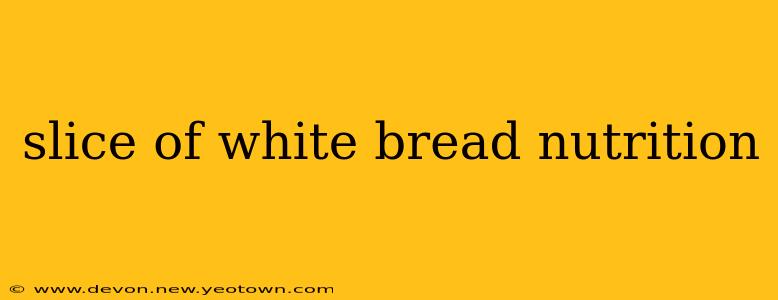We all know it: the soft, fluffy comfort of a slice of white bread. But beyond its satisfying texture and versatile nature, what's really in that seemingly simple staple? Let's take a closer look at the nutritional profile of white bread, exploring its benefits, drawbacks, and answering some common questions.
Our journey begins with a single slice, a seemingly insignificant piece of our daily diet, yet one that holds a surprising amount of nutritional complexity. From its carbohydrate content to its subtle vitamin and mineral contributions, we’ll unravel the mysteries of white bread nutrition.
What are the Nutritional Benefits of White Bread?
White bread, despite its often-maligned reputation, does offer some nutritional benefits. It's a source of carbohydrates, providing the body with energy. While it's often lower in fiber than whole-wheat bread, it still provides a small amount, contributing to overall daily intake. Furthermore, many commercially produced white breads are fortified with essential vitamins and minerals, such as iron and B vitamins. These additions help boost its nutritional value beyond what the simple flour alone offers. It’s important to note that the level of fortification varies depending on the brand and specific product.
How Many Calories are in a Slice of White Bread?
The caloric content of a slice of white bread typically falls between 70-80 calories. However, this number can fluctuate depending on the brand, size of the slice, and any added ingredients like sugars or fats. Checking the nutrition label on the specific bread product is crucial for accurate calorie information. This seemingly small number of calories can quickly add up, especially if you’re consuming multiple slices throughout the day. Therefore, mindful consumption is key.
Is White Bread Good for Weight Loss?
This is a question that sparks considerable debate. While white bread is relatively low in calories compared to other carbohydrate sources, its low fiber content means it doesn't provide much satiety. This can lead to increased hunger and potentially hinder weight loss efforts. Consuming whole-wheat bread, rich in fiber, is often recommended for weight management due to its superior ability to keep you feeling full for longer. However, white bread can be part of a balanced weight-loss diet when consumed in moderation and as part of a broader healthy eating plan.
What are the Downsides of Eating White Bread?
The primary drawback of white bread is its lower fiber content compared to whole-wheat varieties. Fiber is crucial for digestive health, promoting regular bowel movements and helping to regulate blood sugar levels. The refining process that creates white flour strips away much of the beneficial fiber and some essential nutrients present in the whole grain. Additionally, some white breads contain high levels of added sugars and sodium, which can be detrimental to overall health if consumed regularly in large quantities.
Is White Bread Healthy?
The "healthiness" of white bread is subjective and depends heavily on individual dietary needs and overall eating habits. When consumed in moderation as part of a balanced diet, it poses no significant health risks for most people. However, relying on it as a primary source of carbohydrates could lead to nutritional deficiencies due to the low fiber and often lower micronutrient content compared to whole-grain options. Prioritizing whole-grain breads is generally advisable for optimal nutritional intake.
What are the Differences Between White Bread and Whole Wheat Bread?
The key difference lies in the milling process. Whole wheat bread uses the entire wheat kernel—bran, germ, and endosperm—resulting in a higher fiber content, more nutrients, and a denser texture. White bread, conversely, utilizes only the endosperm, a process that removes much of the fiber and nutrients. This leads to the differences in taste, texture, and nutritional profile we discussed earlier.
This detailed exploration of white bread nutrition sheds light on its place within a balanced diet. While not necessarily unhealthy in moderation, prioritizing whole-grain options offers significantly more nutritional benefits. Always check nutrition labels and make informed choices to best support your personal health goals.

